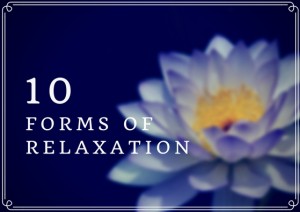
There has been a tendency recently – unfortunately – that it is fashionable to be busy, to be always on the (smart) phone and to be in a hurry. This hectic, running lifestyle we have picked up lately does not do our health any good. Quite the opposite!
Stress infiltrates our life like a cloud dropping rain that, in the end, drowns us.
According to several studies the following factors are most certainly behind our stressful life:
- Environmental factors: Our living space, surrounding, daily weather, traffic…
- Social factors: Financial problems, deadlines, conflicts with colleagues, loved ones…
- Physiological factors: Nutrition problems, sleeping patterns, health problems…
- Thoughts: Perceptions, behavioural imbalances, worrying…
When these elements cumulate they can lead to mental and physical illnesses and to a state where the body literally begs for some dearly needed relaxation time.
So why not go ahead and prevent these things from happening? By dedicating regular quality relaxation time to our daily, weekly, monthly schedule we can sidestep several possible health problems connected to stress.
There is a solid connection between relaxation and our mental and physical health.
Taking our regular “Zen time”:
- Keeps stress levels under control
- Lowers our risk of stroke
- Preserves a stable mental health
- Improves general well-being
- Promotes regular sleeping-patterns
- Helps us focus and concentrate
- Strengthens the immune system
- Helps make better decisions
- Enhances overall life quality
There is a myriad of different methods how to chill out, therefore it is important to find your proper form of relaxation that works for us and can unwind our mind.
Spa owners sometimes struggle with the decision which treatment to offer on their spa menus, how safe they are and whether the treatments are considered to be stand-alone forms of relaxation or complementary treatments. (We will discuss complementary treatments in detail in one of our future posts.)
So let’s have a look at some very popular forms of relaxation.
First of all we differentiate between active and passive forms of relaxation. Active relaxations most of the time are creative ones, like colouring, drawing, painting, photographing etc.; or are connected to nature, such as climbing, walking or hiking. Passive relaxations are more applicable and suitable for spas and wellness centres. Below we introduce a few popular relaxation techniques – from A like “Aura-Soma” to Z like “Zen garden” – although the possibilities are variable and endless.
Aura-Soma
This is a special type of colour therapy, working with amazingly beautiful coloured liquids in lovely bottles. This system was created based on the living energies of plants, minerals and lights. Bright colours and exquisite fragrances appeal to all senses.
Biofeedback relaxation
This is a particularly popular, trending relaxation form. With the help of small electronic devices placed on the skin, different functions of the body are measured and monitored.
Breathing exercises
Practitioner teaches client to be aware of his/her breathing, to focus on slow, deep rhythms.
Colour Therapy
Colour therapy is another form of energy medicine. Colours, just like sounds vibrate at specific frequencies. Colour therapy is often combined with chakra therapy, where the seven main energy centres – chakras/wheels – of the body are treated with different colours. Chakras play a highly important role in our well-being as they connect the meridians to the organs. If chakras cannot serve their functions, organs and cells won’t receive the necessary nourishment to stay vital.
Guided Imagery
Clients are taught to focus their mind on positive images presented to them by stories or on pictures.
Meditation
Several types of meditation can be applied to achieve relaxation. This practice is a mental exercise, which reaches a stress–free condition solely through the mind, positively influencing the body in the process.
Progressive muscle relaxation
This technique applies sequentially tensing and relaxing different muscles. The relaxation is achieved by realizing the contrast between the tensed and still states.
Sound therapy
Sound is applied to treat the body both physically and mentally. Every sound has a particular vibration level and every cell in our body vibrates on a specific level, too. As our entire being is formed by energies, these energy fields interact with each other. Sound therapy can be combined with chanting, musical instruments, singing bowls and/or meditation.
Yoga
Yoga consists of a series of stationary and moving poses, combined with deep breathing and several stretching movements, which have stress relieving, calming and balancing effects.
Zen gardens
These beautifully organized gardens provide an area for quieting mind and soul. Mostly, Zen gardens are built in minimalist style, with stones, gravel and bamboo paths, and natural water elements. The energy of the gardens allows the yin and yang to flow freely.
Please note that these forms of relaxation need recurrence until they become really effective. One-time practice might give you relief and enjoyment, but for a long-term balanced well-being repetition is needed.
As always, be careful with the possible contraindications. Generally speaking, relaxation techniques are considered to be absolutely safe, nevertheless it is recommended to ask for professionals’ advice if you are unsure. Do not apply the techniques in case of epilepsy or any psychiatric illnesses without medical supervision.
